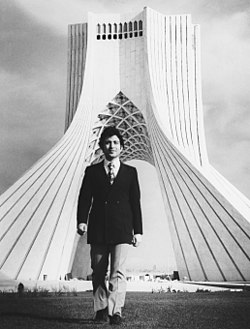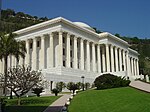Hossein Amanat
| Hossein Amanat | |
 | |
| Född | 1942[1] Teheran, Iran |
|---|---|
| Medborgare i | Iran och Kanada |
| Utbildad vid | Teherans universitet |
| Sysselsättning | Arkitekt |
| Noterbara verk | Azaditornet |
| Redigera Wikidata | |
Hossein Amanat (lyssna ; persiska: حسین امانت), född 1942,[2] är en iransk-kanadensisk, Bahai-troende arkitekt som ritat tre av byggnaderna i Bahai-världscentret i Haifa i Israel samt Bahais bönehus i Tiapapata på Samoa.[2][3][4][5]
Han har examen från Teherans universitet och har även ritat Azaditornet samt några av byggnaderna vid den tekniska högskolan Sharif i Teheran.[6]
Efter den iranska revolutionen 1979 startade förföljelser av Bahai-troende som tvingade Amanat att lämna Iran. Även hans vän och kollega Fariborz Sahba lämnade landet. Båda är nu verksamma i Kanada.
Universella rättvisans hus
Centret för studier av de heliga skrifterna
Referenser
- ^ Union List of Artist Names, ULAN: 500227616, omnämnd som: Hossein Amanat, läs online, läst: 9 oktober 2017.[källa från Wikidata]
- ^ [a b] Bahá'í community of Canada. ”Hossein Amanat”. Arkiverad från originalet den 27 oktober 2004. https://web.archive.org/web/20041027082645/http://www.ca.bahai.org/main.cfm?SID=78. Läst 29 april 2007.
- ^ ”Royal welcome at jubilee gathering in Samoa”. Bahá'í World News Service. 30 november 2004. http://news.bahai.org/story/337. Läst 5 januari 2008.
- ^ Todd, Douglas (21 maj 2001). ”2 B.C. architects designed new world centre for Baha'i faith”. Vancouver Sun. Arkiverad från originalet den 20 oktober 2007. https://web.archive.org/web/20071020085859/http://www.haifa.de/architects.htm. Läst 6 januari 2008.
- ^ ”Northern Virginia Bahá'í Center Opens Its Door”. 23 augusti 2007. http://www.novabc.org/. Läst 6 januari 2008.
- ^ Hossein Amanat's official website. ”Aryamehr University”. Arkiverad från originalet den 19 november 2008. https://web.archive.org/web/20081119140505/http://www.amanatarchitect.com/aryamehr/aryamehr.html. Läst 29 april 2007.
|
Media som används på denna webbplats
Icon of simple gray pencil. An icon for Russian Wikipedia RFAR page.
Författare/Upphovsman: Diako1971, Licens: CC BY-SA 4.0
Pronunciation recording of name "حسین امانت". recorded by native Persian speaker from Tehran, Iran.
Seat of the Universal House of Justice, the supreme governing body of the Baha'i Faith, in the city of Haifa, Israel.
Imperial Coat of Arms of Iran under the Pahlavi Dynasty, used from 1925 to 1979. The shield is composed of the Lion and the Sun symbol in first quarter , in the second quarter the Faravahar representing Zoroastrianism, in the third quarter the curved blade of a Imam Ali "Zulfiqar" sword representing Shia Islam, and the Simurgh in the fourth quarter. Overall in the center is a circle depicting Mount Damavand with a rising sun, the symbol of the Pahlavi dynasty. The shield is crowned by the Pahlavi crown and surrounded by the chain of the Order of Pahlavi. Two lions rampant regardant, holding scimitars supports the coat of arms on either side. Under the whole device is the motto: "Mara dad farmud va Khod Davar Ast" ("Justice He bids me do, as He will judge me" or, alternatively, "He gave me power to command, and He is the judge"). Some of the colours were changed in 1971.
حسین امانت، معمار برج آزادی (شهیاد) تهران در دهه 1350 خورشیدی
Författare/Upphovsman: Beberlola, Licens: CC BY-SA 4.0
This is a photo of a monument in Iran identified by the ID









